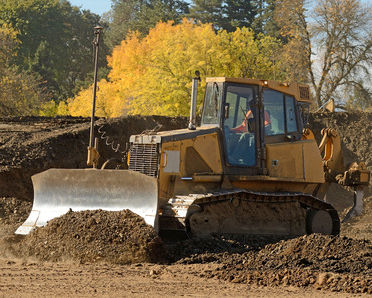18.B.13 Rollover Protective Structures (ROPS).
- In addition to the requirements of Sections 18.B.09 and 18.B.11, seat belts and ROPS must be installed on:
- (1) Crawler and rubber-tire tractors including dozers, push and pull tractors, winch tractors, and mowers;
- (2) Off-the-highway self-propelled pneumatic-tire earth movers (i.e., trucks, pans, scrapers, bottom dumps, and end dumps);
- (3) Motor graders;
- (4) Water tank trucks having a tank height less than the cab; and
- (5) Other self-propelled construction equipment such as front-end loaders, backhoes, rollers, and compactors.
- ROPS are not required on:
- (1) Trucks designed for hauling on public highways;
- (2) Crane-mounted dragline backhoes;
- (3) Sections of rollers and compactors of the tandem steel-wheeled and self-propelled pneumatic-tired type that do not have an operator's station;
- (4) Self-propelled, rubber-tired lawn and garden tractors and side-boom pipe laying tractors operated solely on flat terrain (maximum 10º slope; 20º slope permitted when off- loading from a truck) not exposed to rollover hazards; and
- (5) Cranes, draglines, or equipment on which the operator's cab and boom rotate as a unit.
- ROPS may be removed from certain types of equipment when the work cannot be performed with the ROPS in place and when ROPS removal is justified and delineated in an AHA and accepted in writing by the GDA.
- The operating authority must furnish proof from the manufacturer or certification from a licensed engineer that the ROPS complies with applicable SAE Standards (i.e., J167, J1040, J1042, J1084, and J1194).
- ROPS must also be acceptable if they meet the criteria of any State that has a Department of Labor-approved OSHA program or meets Water and Power Resources Service requirements.
- The following information permanently affixed to the ROPS is acceptable in lieu of a written certification:
- (1) Manufacturer's or fabricator's name and address;
- (2) ROPS model number, if any; and
- (3) Machine make, model, or series number that the structure is designed to fit.
- Field welding on ROPS must be performed by welders who are certified, per Section 10.A.07.
18.B.14 All points requiring lubrication during operation must have fittings so located or guarded to be accessible without hazardous exposure. > See also Section 12.
18.B.15 All machinery or equipment and material hoists operating on rails, tracks, or trolleys must have positive stops or limiting devices either on the equipment, rails, tracks, or trolleys to prevent overrunning safe limits.
18.B.16 Under the following circumstances, long-bed end-dump trailers used in off-road hauling should be equipped with a rollover warning device. The device should have a continuous monitoring display at the operator station to give the operator a quick and easily read indicator and audible warning of an unsafe condition:
- The material being dumped is subject to being stuck or caught in the trailer rather than exiting the bed freely, and
- The dumpsite cannot be maintained in a nominally level condition (lateral slope less than 1º - 2º).
18.C Operating Rules.
18.C.01 General. For the purpose of this paragraph, a government-owned motor vehicle is any vehicle (government-owned; POV or Rental Car if being used while on-duty in lieu of government-owned vehicle) used to transport Government employees.

- Operators of Government and Contractor motor vehicles being used on USACE projects may only use cellular telephones with hands-free devices while the vehicle is in motion.
- (1) Prior to using a hand-held cellular phone, drivers must find a safe place to bring their vehicle to a stop.
- (2) Text messaging by the operator is strictly prohibited while operating motor vehicles.
- The use of any other portable headphones, earphones, or other listening devices (except for hands-free cellular phones) while operating Government or contractor motor vehicles on USACE projects is prohibited. > See AR 190-5.
- Operators of government-owned motor vehicles (whether government- or contractor- operated, GOGO or GOCO) must not eat, drink alcohol, or smoke while the vehicle is in motion.
- GPS Systems.
- (1) GPS systems must be mounted within the vehicle so that they do not create sight hazards for the operator.
- (2) Programming of GPS systems while driving is prohibited.
- (3) The use of non-mounted GPS systems may only be used by the vehicle operator while the vehicle is in a stopped position.
Knowledge Check Choose the best answer for the question.
18-4. Which of the following requires Rollover Protective Structures (ROPS)?
You forgot to answer the question!

